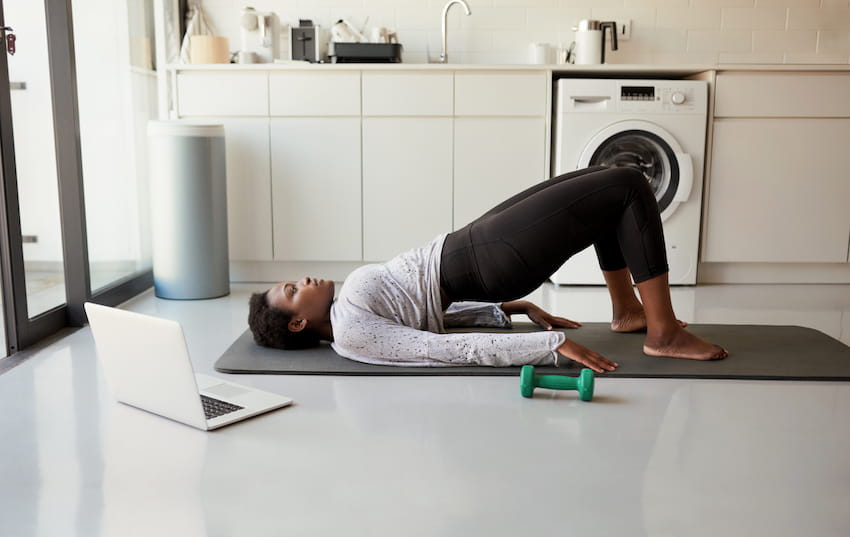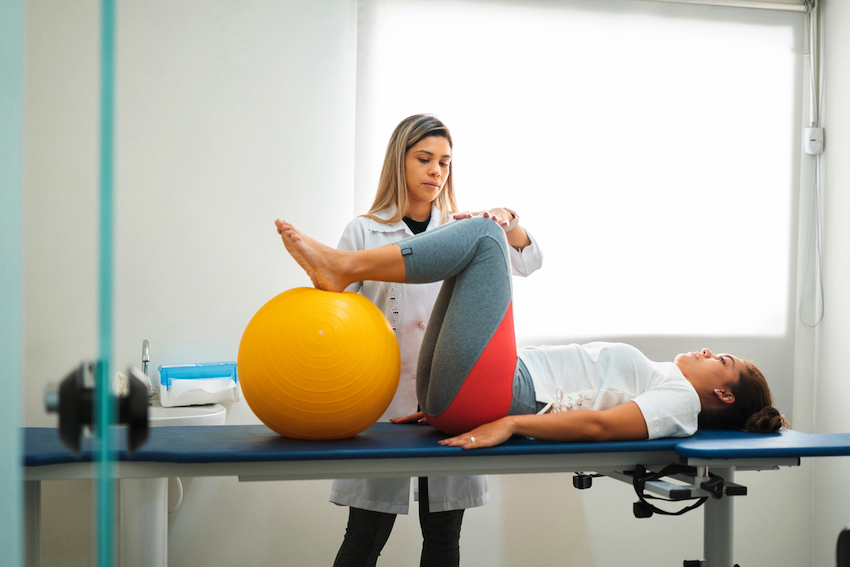How to do pelvic floor exercises correctly to improve pelvic conditions

Many of the symptoms that are caused by pelvic floor conditions like urinary incontinence and pelvic organ prolapse are exacerbated by a weak pelvic floor.
Pelvic floor conditions can improve with pelvic floor stretches and exercises. Women with these conditions are often advised to seek pelvic floor physical therapy. These pelvic floor rehabilitation specialists can teach you how to do pelvic floor exercises correctly to improve pelvic conditions such as prolapse and certain bowel issues, constipation, incontinence, or pain with bowel movements.
Michele Branca, a Main Line Health physical therapist who focuses on pelvic floor health, sees patients with all types of pelvic pain — in the back, the hips, the pelvis, the vagina, and the rectum. She also sees patients who are recovering from surgery or pregnancy. Transgender patients who recently underwent surgery during their transition are also likely to see a pelvic health therapist.
Over time, exercises to strengthen the pelvic floor can reduce symptoms, and in some cases, cure certain conditions like incontinence. Pelvic floor exercises can also alleviate pelvic pain, improve sexual function, and facilitate healthy bowel movements.
What are some helpful pelvic floor exercises?
The most common pelvic floor exercises are Kegels, or intentional pelvic floor contractions. Kegels can be done in many different ways and are especially helpful for people with prolapse and urinary incontinence.

"The idea is to strengthen and train the muscles that help the pelvic floor," says Mitchell Berger, MD, PhD, a female pelvic medicine and reconstructive surgery specialist with Main Line Health.
Branca teaches patients Kegel exercises which isolate the use of the pelvic floor at first, and then adds more advanced exercises such as bridge pose or ball squeezes to elicit a stronger muscle contraction. To do a Kegel:
- Squeeze your pelvic floor.
- Hold the squeeze for a few seconds
- Slowly relax it.
To get a feel for what constitutes a Kegel, try to bring your stream to a full stop while urinating — if you can, that's a good contraction. This is a one-and-done strategy; don't routinely practice Kegels on the toilet, as this could disrupt urine flow.
Berger recommends doing 10 repetitions three times a day. Slowly build up so you can hold the squeeze for 10 seconds at a time. As you get stronger, practice in various positions — laying down, laying upward, sitting up, and standing.
"There is a progression that we teach people so that they learn it in a lot of different ways," says Branca.
It's also crucial to practice diaphragmatic breathing when doing pelvic floor stretches and exercises.
"Every person should be looking at how they're breathing," Branca says. If you're not breathing properly during your pelvic floor exercises, you won't be able to connect the pelvic floor to the lower abdomen muscles and the diaphragm, which can make the exercises more difficult.
Pelvic floor stretches are a huge piece of the puzzle as well, adds Branca. This can include external stretching (hips, core, abdominal muscles, back) along with internal stretching (the pelvic floor). You can put yourself in a lengthened position or use an internal stretching tool like a wand.

How to make the most of your pelvic flor exercises
Berger recommends practicing the exercises with a physical therapist.
"The studies all show that one-on-one training definitely is better," Berger says.
Pelvic floor therapists have extensive education and training to understand the connective tissues and identify other problems. Plus, all of your exercises can be better tailored and personalized to your specific problem areas when you work with a professional. They may also use various props, such as an exercise ball, to stimulate the muscles and provide feedback to help train the appropriate muscles.
While there are many benefits to pelvic floor exercises, keep in mind that most physical therapy can be strenuous or cause soreness in the beginning.
"You're going to be sore because you're working muscles that may not have been doing much before," Berger notes. Some people may develop painful muscle spasms while learning how to do pelvic floor exercises correctly. A physical therapist can also help with relaxation and stretching exercises, rather than strengthening exercises, to help alleviate these spasms.
A lot of people wind up doing the exercises incorrectly, Berger says. Many people accidentally engage the glutes, core muscles, or abdominal muscles rather than their pelvic floor muscles. Branca commonly sees people holding their breath during their exercises, too.
Pelvic floor exercises aren't for everybody
According to Branca, not everybody with a pelvic floor condition will benefit from pelvic floor strengthening exercises. Sometimes, the pelvic floor muscles are overly tight. If that's the case, pelvic floor exercises can actually do more harm than good.
"If you're trying these exercises to strengthen your pelvic floor and not getting the results you expect, talk to a health care practitioner," Branca advises. There's a chance the exercises may be tightening already tense muscles. A trained pelvic floor physical therapist can teach you how to properly do the exercises and provide feedback so you can achieve your goals.
Main Line Health serves patients at hospitals and health centers throughout the western suburbs of Philadelphia. For more information or to schedule an appointment with a pelvic floor specialist at Main Line Health, call 1.866.CALL.MLH (225.5654) or visit mainelinehealth.org.
 Content you want, delivered to your inbox
Content you want, delivered to your inbox
Want to get the latest health and wellness articles delivered right to your inbox?
Subscribe to the Well Ahead Newsletter.
